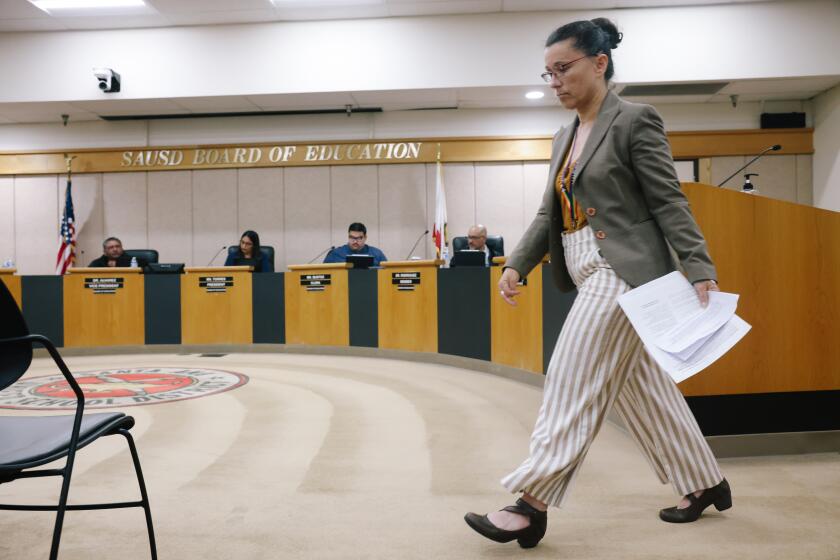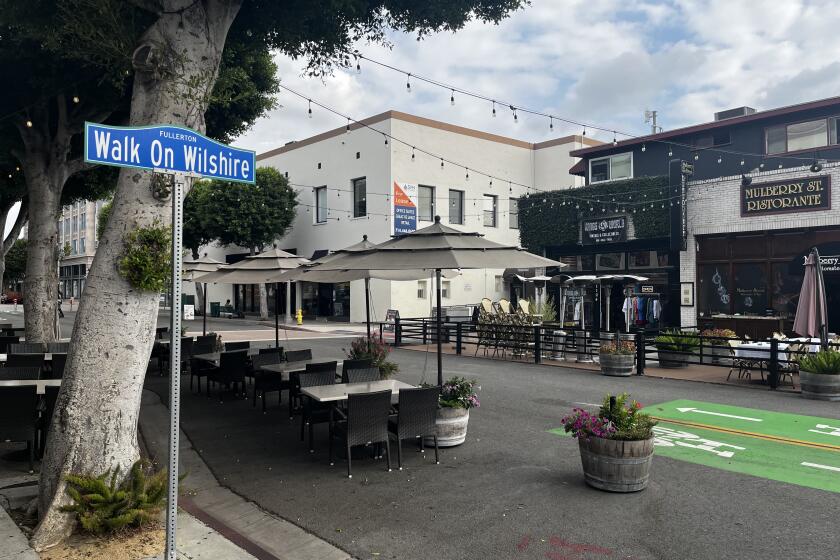Pablo Picasso’s ‘The Frugal Meal’ among prints up for auction to help feed Orange County
- Share via
At the center of an auction aiming to rake in about $600,000 is a signature piece by 20th-century artist Pablo Picasso that speaks to the times.
A monochromatic man and woman sit side by side. Their fingers are bony and elongated, cheeks hollow and elbows resting on a table with empty plates. The man is blind, and the woman stares directly at the viewer with tired eyes.
Picasso’s work, “Le Repas Frugal” translated to “The Frugal Meal,” is said to depict two acrobats. A struggling artist himself at the time, Picasso had limited art supplies and refurbished a zinc plate to create the etching. The piece dates to 1904 when Picasso moved to France and settled into a low-rent tenement building. It is part of the Spanish artist’s Blue Period, dominated by blue hues and depictions of the poor, sick and outcast.
Out of more than 30 Picasso prints in the auction, it’s the only work that was displayed for a short time in the home of its once-private owner, Harald Herrmann, CEO of Second Harvest Food Bank of Orange County. The rest of Herrmann’s collection remained either on public display in museums or in temperature-controlled storage.
“He was a young man trying to find his way, and hunger was prevalent all around him at the time,” said Herrmann. “This print is something that moved me, and I’ve been a merchant of food my whole life. I’ve made a living selling food. Now I don’t sell it. We give it away. But this piece just kinda connects all those dots.”
Herrmann spent 40 years in the restaurant business. He started as a dishwasher at a Marie Callender’s in Orange County at 17 years old. He worked his way up to the point of co-founding Yard House out of Long Beach. He spent 20 years with the brand and eventually took a CEO position with Mendocino Farms. Wanting to dive into the nonprofit world, he joined Second Harvest in March 2019.
When he began acquiring the prints about 20 years ago with the help of local curator Reilly Rhodes, he had planned to eventually sell the collection to fund a portion of his retirement keeping his name anonymous. But this month Herrmann is collaborating with Christie’s, a global auction house, to publicly sell the artwork.
He plans to donate 10% of gross proceeds to Second Harvest. Christie’s will donate half of their commission to Feeding America. The rest of the proceeds will be reinvested in other assets yet to be determined by Herrmann.
The conversations to launch the online auction, titled “Nourishment for the Soul,” started at the end of the spring.
“It’s such a fantastic collection to offer specifically online but also because of the COVID moment that we are all in,” said Lindsay Griffith, who manages Christie’s prints and multiples auctions. “It really felt like being able to sell this and to have a dialogue was a convergence of those narratives during this time of such extraordinary need.”
The auction house is global with sites in Los Angeles, San Francisco, New York, London, Paris and Hong Kong. Most of the auctions in the U.S. have been modified as phone bids or online auctions.
“We’ve seen a lot of bidding activity globally. I think there is still quite a bit of interest in the art market,” Griffith said.
Pricing for prints is determined by the amount it most recently sold for in the market as well as the rarity and condition of the artwork.
Griffith describes Herrmann’s collection as thoughtful and classic. It ranges from etchings, drypoints and prints that span from 1904 to 1937, covering cubism, classicism and surrealism.
There are a wide range of price points in the auction. “The Frugal Meal” is the most expensive piece estimated at $100,000 to $150,000. The least expensive pieces, like “Sculpteur modelant, from Le Chef-d’œuvre Inconnu,” are expected to sell at $1,000.
“[Picasso] was quite a prolific printmaker. So there are a number of them in each auction. I would say, together with Warhol, they account for quite a significant portion of the works offered in our sales,” said Griffith.
The online auction began Sept. 2 and is scheduled to run through Sept. 18.
Although Christie’s clients have sold collections to benefit charities, Griffith said the department donating half of their commission is an unusual circumstance.
Herrmann said he hopes going public will inspire advocacy and hunger awareness to an audience in the art community as the demand for food tripled while about 34% of Second Harvest’s network, such as houses of worship, schools and soup kitchens, closed their doors at the start of the pandemic.
The food bank prepared for COVID-19 in late February with its first order of face masks. By the first week of March, it had a crisis plan for its donors and pantry network including an expected high amount of unemployment through the June of next year.
Previously, the nonprofit relied on about 26,000 annual volunteer visits to help process food. Now, it had to figure out how to move food without volunteers. Traditional canned food drives turned into virtual drives collecting monetary donations rather than physical food. Distribution plans accommodated a two-week supplemental food box through the Kids Cafe program, pop-up drive-throughs, food-box drop-offs at homes and senior living centers and a continual push out to pantry centers across 34 cities equipped to build and staff pickup areas.
Second Harvest partnered with Goodwill to use additional trucks and drivers. It brought in 120 team members, who were recently laid off or furloughed, as part-time employees.
Herrmann described the changes at Second Harvest as successful and thriving but also said it’s ironic.
“We’re not in the business of wanting to serve more people that need our support. We’d like to have that line decreased and put ourselves out of business. That would be success. So it’s a strange paradigm,” Herrmann said.
He notes that although the news isn’t covering cars lining up for food as often as the beginning of the pandemic, there is still a food crisis, and it’s far from over.
In February, Second Harvest moved 2.2 million pounds of food to about 249,000 O.C. residents. At the highest point during the pandemic, 7.4 million pounds of food were distributed. They are currently moving about 6 million pounds of food a month to over 500,000 residents.
“It is a marathon, and we have lots of work ahead of us. There’s a newly vulnerable population of families that were several paychecks away from needing to get in a food line, which has really revealed a risk in our community, especially with lower-middle-class families without paychecks for several weeks,” said Herrmann. “Children being home-schooled, daycare issues — just all the things that are being thrown at families right now, there’s a lot that we still have to figure out as a community.”
All the latest on Orange County from Orange County.
Get our free TimesOC newsletter.
You may occasionally receive promotional content from the Daily Pilot.




